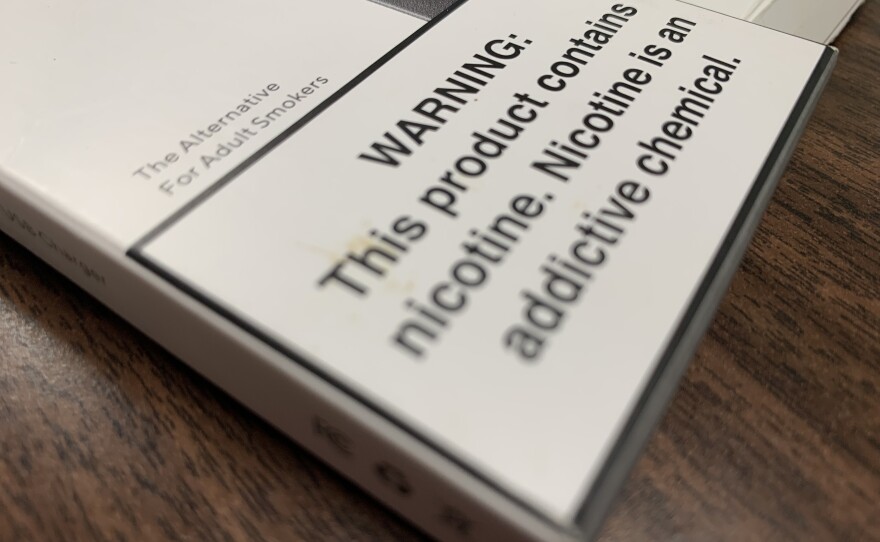A Tulare County resident this week became the seventh person in the U.S. to die from a vaping-related respiratory illness. The national outbreak has put a spotlight on the risks associated with electronic smoking devices, especially among youth.
The nonprofit Social Advocates for Youth (SAY) San Diego delivers tobacco and vaping prevention seminars to local students and is receiving more requests for its training since the surge of illnesses.
Mary Baum, SAY San Diego's senior director of alcohol, tobacco and other drug prevention, said the group presented to seven schools in all of last year. But far more have already contacted her since this school year began a few weeks ago.
"We’ve been getting calls every week. At least three of four calls a week from schools; nontraditional schools, middle schools — a lot of middle schools are calling," Baum said.
Baum said school faculty and police have confiscated THC and nicotine vaping products, including chocolate milk e-liquid and mango-flavored nicotine pods, from students on campuses. She said some youth are using the devices while at their desks.
"Kids tend to blow out, exhale their smoke or their vapor into their sleeves and they have been using these in class," Baum said.
Electronic cigarette use among San Diego youth recently increased, according to the California Healthy Kids survey. The 2016-17 data showed among the roughly 15,000 San Diego Unified students surveyed, 1 percent of 7th-graders, 3 percent of 9th-graders and 2 percent of 11th-graders reported vaping at school within the previous 30 days. The following year, those figures rose to 4, 8 and 6 percent, respectively.
SAY San Diego's presentation, which is modified from a Stanford University module, focuses on nicotine with information about cannabis. It explains which pods used in vaping devices contain more nicotine than a pack of cigarettes and how that translates to a potentially higher intake, Baum said.
"To smoke a whole cigarette, and then to re-light another one -- that's very active and there's some time to it," she said. "With these pod-based systems, they just suck, suck, suck, suck, suck, and before they know it, they've smoked a pack and a quarter."
The training also examines the physical impact of the substance and discusses addiction.
Federal health officials haven't yet identified the cause of the current outbreak of vaping-related pulmonary disease, but most of the 380 patients reported using cannabis by itself or in addition to nicotine.
Health department officials in Tulare County didn't disclose the substance used by the patient who died nor the person's age. The Centers for Disease Control and Prevention have not yet confirmed the California county's death in its tally, according to its website.
RELATED: The Vaping Illness Outbreak: What We Know So Far
Health officials in most other states that reported deaths also withheld information about substances used, but officials in Minnesota said a vaping-related death there was linked to "illicit THC products" and in Oregon, a person who is suspected to have died from the disease reportedly used a cannabis product purchased from a dispensary.
California Gov. Gavin Newsom issued an executive order Monday to roll out a $20 million awareness campaign next month about the harmful side effects of vaping both nicotine and cannabis. The governor's order also directs staff to develop recommendations for raising taxes on liquid nicotine, adding warnings to vaping packaging and stepping up its enforcement against unlicensed products.
San Diego-based California Vaping Company co-founder Dakoda Collins said he supports additional regulations to stop youth vaping. He said the company recently updated its labels to be less appealing to younger consumers.
“It’s a very simple font; there’s no cartoons, there’s no pictures of food, so for our finished products we’re trying to go to a 30-year-old market," Collins said Monday in a phone interview with KPBS.
At the federal level, the Department of Health and Human Services announced last week it plans to issue new regulations for flavored nicotine liquids.
“The Trump Administration is making it clear that we intend to clear the market of flavored e-cigarettes to reverse the deeply concerning epidemic of youth e-cigarette use that is impacting children, families, schools and communities,” HHS Sec. Alex Azar said in a Sept. 11 news release.
The department's statement referenced preliminary data from the National Youth Tobacco Survey that found more than a quarter of surveyed high school students reported vaping within 30 days, "and the overwhelming majority of youth e-cigarette users cited the use of popular fruit and menthol or mint flavors."

In response, the popular e-cigarette and flavored nicotine pod maker JUUL said it welcomed new rules.
"We strongly agree with the need for aggressive category-wide action on flavored products," the company said in a statement on its website. "We will fully comply with the final FDA policy when effective."
The Food and Drug Administration previously warned the company it was illegally marketing its products as safer than cigarettes, including to youth.






